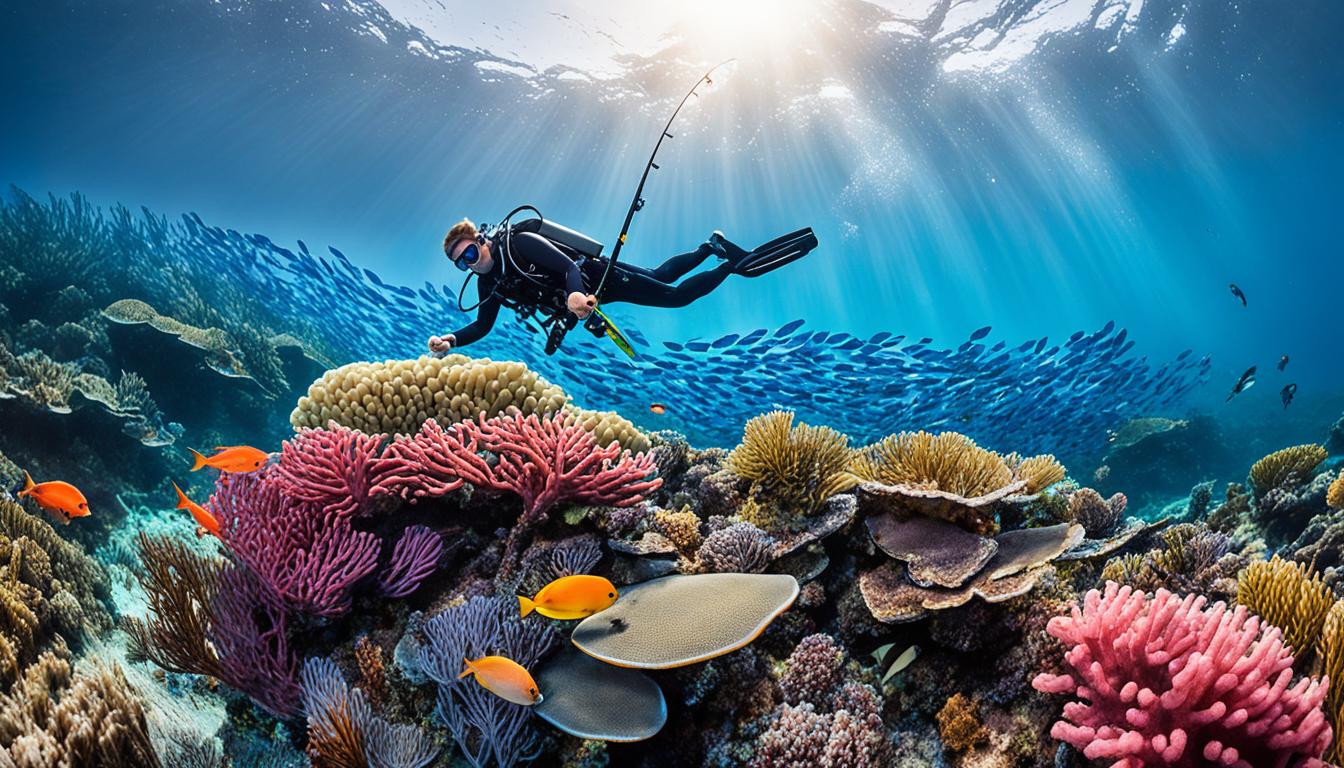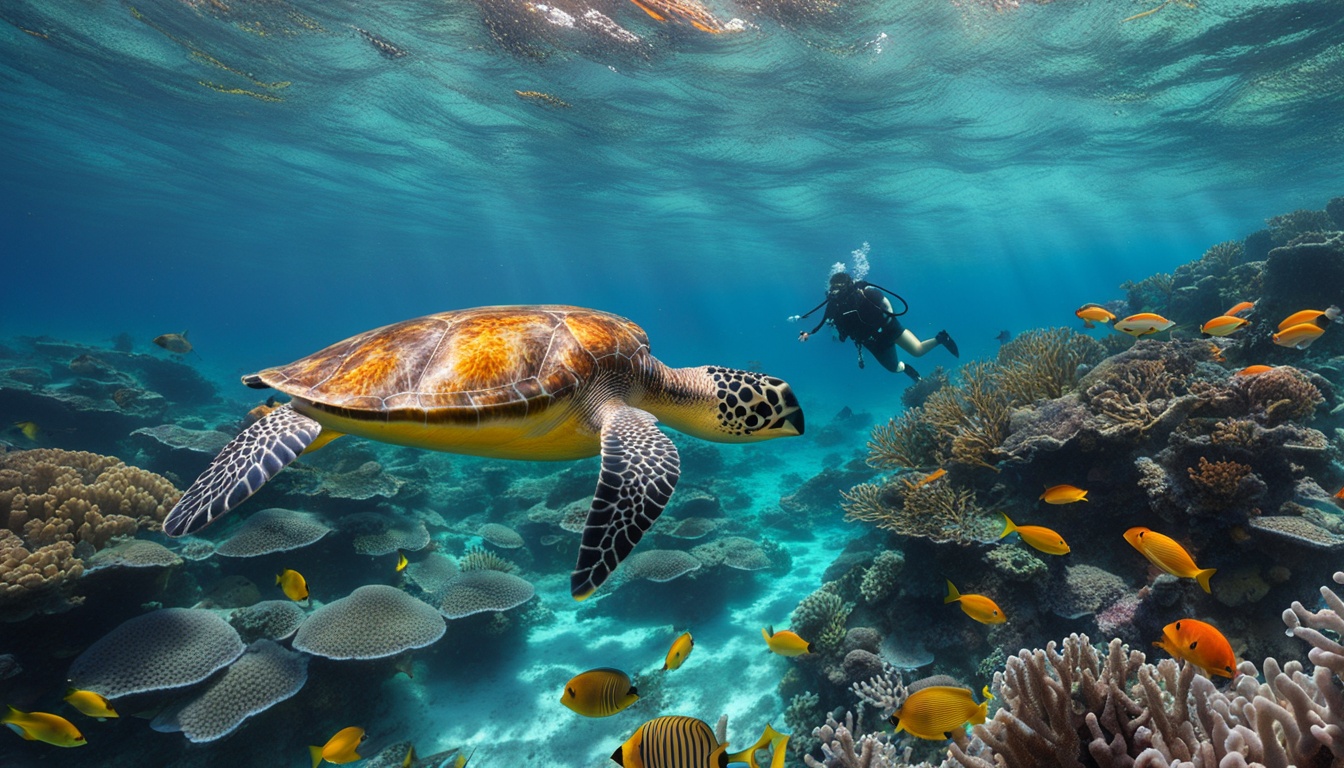Imagine the thrill of free diving into the crystal-clear waters of Queensland, Australia, surrounded by an abundance of marine life. With your spearfishing equipment in hand, you explore the vibrant underwater world, searching for that perfect catch. But before you embark on your spearfishing adventure, it’s crucial to familiarize yourself with the spearfishing rules QLD to ensure a safe and sustainable experience.
Spearfishing in Queensland offers a unique opportunity to engage with the ocean and partake in a thrilling form of underwater hunting. However, the Queensland Government has implemented various regulations to protect marine resources and promote responsible fishing practices. These rules encompass different aspects of spearfishing, including gear restrictions, catch limits, and fishing hours.
Key Takeaways:
- Follow the spearfishing rules QLD to ensure a sustainable fishing experience.
- Be aware of gear restrictions, including net sizes, number of crab pots, and hook limits.
- Understand the regulations for scoop and dip nets, seine nets, and freshwater fishing gear.
- Stay informed about specific rules regarding traps and canister traps.
- Explore beginner-friendly spearfishing spots and access dive shops in the Gold Coast area.
Fishing Gear Restrictions
When it comes to fishing in Queensland (QLD), it’s essential to be aware of the fishing gear restrictions in place to ensure sustainable fishing practices and preserve our marine ecosystem. These restrictions are designed to protect fish populations and maintain a balance between recreational fishing and environmental conservation.
One of the key fishing gear restrictions pertains to cast nets. In QLD, the maximum net size for cast nets is 3.7m, with a maximum mesh size of 28mm. These limitations help prevent overfishing and protect smaller or juvenile fish, allowing them to grow and contribute to the overall fish population.
Additionally, there are regulations on the number of crab pots or dillies that individuals can use. Fishing enthusiasts are allowed up to four crab pots or dillies per person. It is important to attach a tag with your surname and address clearly visible to each pot or dilly to comply with the regulations and identify your gear.
When it comes to fishing lines, there are specific restrictions on the number of lines and hooks that can be used. Anglers are permitted to use up to three lines with a maximum of six hooks in total, whether handheld or attached to a rod or reel. However, it’s important to note that certain types of lines may have further restrictions, so it’s vital to familiarize yourself with the specific guidelines.
It’s worth mentioning that these fishing gear restrictions are in place to ensure responsible angling practices and protect our marine resources. By adhering to these regulations, we can contribute to the sustainability of our fishing ecosystem and preserve the thrill of fishing for generations to come.
In summary, when fishing in QLD, it’s crucial to follow the fishing gear restrictions to promote sustainable fishing practices. These restrictions include limitations on cast nets, the number of crab pots or dillies allowed per person, and the use of fishing lines with specified hooks. By respecting these regulations, we can play our part in protecting our marine environment and ensuring the longevity of our favorite pastime.
Responsible Crabbing Guidelines
When it comes to crabbing in Queensland, it’s crucial to follow responsible crabbing guidelines to protect the environment and ensure sustainable crab populations. Here are some important rules and regulations to keep in mind:
- Crab Pot Regulations: When setting crab pots or dillies, ensure they are heavy enough to prevent them from getting lost in strong tidal currents. Attach enough rope to your pots to keep them secure.
- No-Take Crabs: Sort your crabs on a pot-by-pot basis to remove any no-take crabs and release them unharmed. This helps maintain healthy crab populations and supports sustainable fishing practices.
- No Interference: It is illegal to hook crabs or interfere with another person’s crabbing gear. Respect the rights of other crabbers and avoid any actions that may disrupt their fishing activities.
- Report Lost Crab Pots: If you come across derelict, abandoned, or lost crab pots, report them to the relevant authorities. This helps protect marine animals and prevents littering in our waterways.
By following these responsible crabbing guidelines, you can enjoy the thrill of crabbing while contributing to the conservation of crab populations and preserving the beauty of Queensland’s coastal ecosystems.

Remember, responsible crabbing is not only about following the rules, but also about being mindful of the impact of our actions on the environment. By practicing responsible crabbing, we can all play a part in ensuring the sustainability of this beloved recreational activity for generations to come.
Fishing Lines and Digging Forks
When it comes to fishing in Queensland, it’s essential to familiarize yourself with the regulations surrounding fishing lines and digging forks. These regulations ensure the sustainable management of Queensland’s diverse aquatic resources and promote responsible fishing practices.
In terms of fishing lines, anglers are allowed to use up to three fishing lines at a time, with a maximum of six hooks in total. This includes handheld lines or lines attached to a rod or reel. It’s important to note that artificial flies, lures, bait jigs, or gang hooks count as one hook.
For those who prefer to catch their own bait, the use of a digging fork is permitted in most areas. However, it’s crucial to be aware of specific restrictions. For example, there may be worm digging closures in certain locations, or certain marine park zones where the use of digging forks is prohibited.
Remember to always stay with your fishing lines and monitor them closely. This not only ensures your safety but also helps to prevent any potential harm to the environment or wildlife. Adhering to the regulations regarding fishing lines and digging forks allows for a rewarding and sustainable fishing experience.

| Species | Possession Limit |
|---|---|
| All tidal species not listed | 20 |
| Coral reef fin fish (various species) | 20 |
| Spanner crab claws (per crab species) | 20 |
| Blue swimmer crabs (with restrictions) | 20 |
| Mud crabs (per person/boat) | 7/14 |
Scoop and Dip Nets Regulations
When it comes to fishing in Queensland, scoop and dip nets are a popular choice among anglers. These nets are versatile tools that can be used for various purposes, including catching bait, landing fish, or even retrieving lost tackle from the water.
However, it’s important to note that there are certain regulations in place regarding the use of scoop and dip nets to ensure sustainable fishing practices and the protection of aquatic ecosystems.
According to QLD fishing regulations, scoop and dip nets used in tidal waters cannot exceed 2 meters in any dimension. This ensures that the size of the net remains within acceptable limits and prevents excessive capture.
Additionally, scoop and dip nets must have a minimum mesh size of 25mm. This ensures that smaller fish and other aquatic organisms have a chance to escape the net, contributing to the conservation of fish populations and maintaining healthy ecosystems.
It’s worth mentioning that scoop and dip nets can also be used as gaff or landing nets to secure line-caught fish. However, it’s crucial to adhere to the size and mesh requirements specified by the QLD fishing regulations.
Furthermore, the maximum net size for scoop or dip nets in Queensland is 1 meter in any dimension, and the maximum handle length permitted is 2.5 meters. These regulations aim to prevent the excessive use of large nets, which could have negative impacts on fish populations and their habitats.
By following these regulations, anglers can play their part in sustainable fishing practices and contribute to the long-term health and preservation of Queensland’s aquatic resources.

For more detailed information on size and possession limits for both tidal and freshwater fishing, anglers can refer to the Queensland Government website. It provides comprehensive guidelines and regulations to ensure that anglers can enjoy their fishing experience while respecting the environment and its inhabitants.
Spearfishing Regulations
In Queensland, spearfishing regulations permit only freediving; the use of scuba gear is illegal for spearfishing.
Anglers can enjoy spearfishing in selected tidal water locations in Queensland using a spear or spear gun, including a bow for propelling a spear. However, it is important to note that underwater breathing apparatus (other than a snorkel) is not permitted. Power heads are also prohibited, except for defense against sharks.
It is worth mentioning that there are specific regulations regarding spearfishing for barramundi, including restrictions on the time of day. Additionally, spearfishing is not allowed in freshwaters.
To ensure a compliant spearfishing experience in Queensland, it is crucial for anglers to familiarize themselves with these spearfishing regulations.

Freshwater Fishing Gear Restrictions
In Queensland, there are specific gear restrictions in place when it comes to freshwater fishing. These regulations aim to prevent overfishing and protect the fish stock, ensuring the sustainability of our freshwater habitats. As an angler in Queensland, it’s important to be aware of these gear restrictions to promote responsible fishing practices and preserve the natural ecosystem.
Under the Queensland fisheries legislation, which commenced on September 1, 2019, there are limitations on the types of fishing equipment that can be used in freshwater and tidal waters. This includes gear such as cast nets, crab pots, dilly nets, and spearfishing gear.
Freshwater anglers are not allowed to use hand pumps or worm digging forks, as these can disrupt the delicate balance of the ecosystem. It is also prohibited to interfere with gear that you did not set, as this can disrupt other anglers’ fishing activities and be detrimental to the overall fishing experience.
To further protect fish stocks and ensure responsible fishing, there are also possession limits in effect. These limits regulate the amount of fish that anglers can keep and promote conservation of heavily sought-after species. Specific possession limits exist for various species, including coral reef fin fish, groupers, emperors, snappers, and bass, among others. Detailed information on size and possession limits in both tidal and fresh waters can be found on relevant government websites.
In certain waterways, there may be additional closures or regulations to protect endangered or threatened species and prevent overfishing. It’s crucial to stay informed about these specific regulations in the areas where you plan to fish.
Remember, fishing gear can only be possessed in protected areas where fishing is permitted. Visitors must not bring live animals into these areas, except for fish or mud crabs lawfully taken in the area or adjacent places. Fishing competitions are generally prohibited in protected areas, with some exceptions based on specific circumstances.
While spearfishing is not allowed in terrestrial protected areas, it may be permitted in adjacent waters following relevant marine park zoning plans. Stocking fish in protected areas is only permitted for formal programs related to rare or threatened species recovery.
Operators of charter fishing tours need to obtain commercial activity and general fisheries permits to offer their services. It’s important to comply with both fisheries legislation and any specific management rules for protected areas. Management plans and regulations may define specific bag limits for fishing in these areas, varying from the general fisheries legislation.
By adhering to these freshwater fishing gear restrictions and QLD fishing regulations, we can all contribute to the sustainability and conservation of Queensland’s freshwater ecosystems for generations to come.
Freshwater Fishing Gear Restrictions in Queensland
| Type of Gear | Restrictions |
|---|---|
| Cast Nets | Prohibited in freshwater areas |
| Crab Pots | Prohibited in freshwater areas |
| Dilly Nets | Prohibited in freshwater areas |
| Spearfishing Gear | Prohibited in freshwater areas |
| Hand Pumps | Prohibited in freshwater areas |
| Worm Digging Forks | Prohibited in freshwater areas |
| Interfering with Gear | Prohibited |

Traps and Canister Traps Regulations
When it comes to trapping fish and crustaceans in Queensland, it’s important to familiarize yourself with the specific regulations in place. Understanding the rules surrounding traps, including canister traps, can ensure you stay within the boundaries of the law and protect the ecosystem.
Anglers are permitted to use up to four different kinds of traps, such as crab pots, collapsible traps, dillies, funnel or round traps, or open-top pyramid traps. It’s essential to remember that the use of these traps is limited to four per person.
Canister traps are a popular choice among anglers, and there are strict size restrictions that must be followed. These traps must not exceed 60cm in length and have maximum dimensions of 50cm in width, height, or diameter. Additionally, the mesh size of canister traps should not exceed 25mm.
Collapsible traps, on the other hand, must be constructed from rigid materials and have one or more collapsible sides. This design ensures that the traps can be easily disassembled and stored when not in use.
Dillies, which are another type of trap commonly used by anglers, have specific limitations. The maximum net diameter for dillies is 125cm, and the mesh size should not exceed 25mm.
Funnel and round traps have their own set of rules, particularly in freshwater locations. The maximum sizes and entrance regulations for these traps vary depending on the specific freshwater impoundments in which they are used. It’s important to consult the relevant authorities or fishing guidelines to ensure compliance when using these traps.
Remember, in freshwater environments, canister traps should not exceed 60cm in length or 50cm in width, height, or diameter. The mesh size for these traps should not exceed 25mm.
Overall, by adhering to the regulations surrounding traps and canister traps, anglers can enjoy their fishing experience while protecting the environment and abiding by the QLD fishing regulations.

Conclusion
Understanding and complying with the spearfishing requirements in Queensland is crucial for anglers who want to enjoy a sustainable and responsible fishing experience. By following the Queensland spearfishing guidelines, anglers can contribute to the conservation and preservation of the state’s marine resources. These guidelines not only help protect fish populations but also ensure the safety of both the environment and the spearfishers themselves. For visitors, especially those unfamiliar with Queensland’s specific rules, it’s important to review the spearfishing essentials for South Africans to avoid any unintentional violations. By staying informed, anglers can help preserve marine ecosystems while still enjoying the thrill of the sport.
In addition to the regulations, there are various resources available for spearos to enhance their fishing adventures. Spearfishing clubs provide an excellent platform for new spearos to connect with experienced mentors and dive buddies. Facebook spearfishing groups are also popular for sharing information and finding others to dive with.
Furthermore, consulting with local retailers can help anglers connect with experienced spearos in the community. And for scouting potential dive locations and assessing parking spots, Google Earth is a useful tool. It’s important to understand marine protection zones to avoid legal issues and adhere to local regulations.
Lastly, when planning diving trips, weather forecasting websites like the Bureau of Meteorology (BOM) and SeeBreeze can be essential tools for ensuring safety and success. Considering wind speeds and swell size is crucial for shore diving and the visibility of the water, as well as for the safety of entry and exit points.
By engaging in sustainable spearfishing practices, aimed at minimal impact on fish populations and capturing invasive species, spearos actively contribute to marine conservation efforts. Their ecological observations and participation in tournaments further aid in scientific research and help rebalance marine ecosystems.
Spearfishing in Queensland offers not only an exciting adventure but also an opportunity to connect with nature, while ensuring the long-term health and abundance of marine resources. Enjoy your spearfishing experience in Queensland’s waters while adhering to the regulations and guidelines in place.










